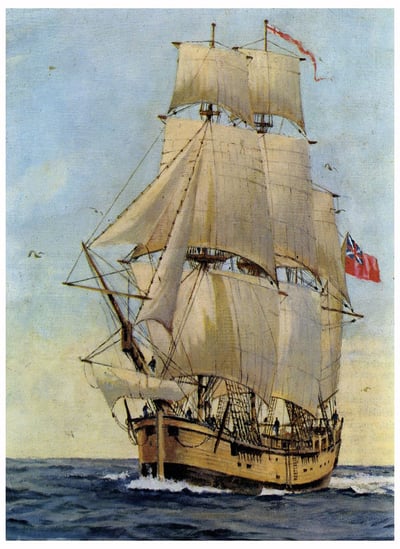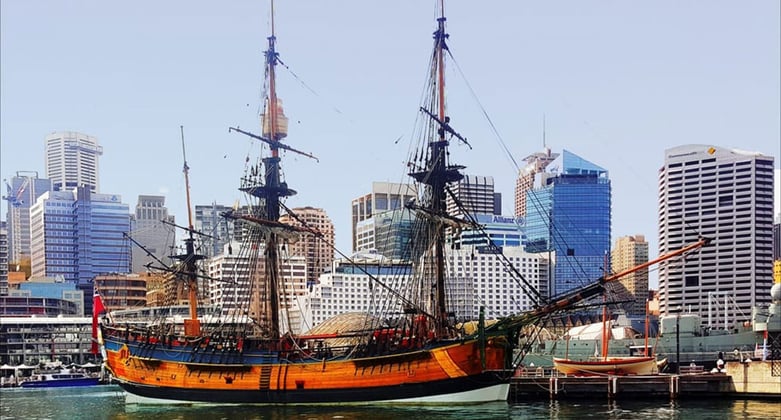 The UMHS Endeavour is the official new name of our medical school’s blog. If you’re a stickler for American-style spelling, don’t be alarmed by the extra “u” because it is not a typo. We’re using the traditional British spelling for good reason.
The UMHS Endeavour is the official new name of our medical school’s blog. If you’re a stickler for American-style spelling, don’t be alarmed by the extra “u” because it is not a typo. We’re using the traditional British spelling for good reason.
(Photo, inset right) HMS ENDEAVOUR: UMHS has re-christened this blog in honor of the ship used by 18th century British explorer James Cook & his devotion to discoveries in science. Photo: Archives New Zealand/Wikimedia Commons
For the past year, we’ve wanted to change the name of the blog, and university staffers in both the North American Administrative Office in New York and St. Kitts have submitted numerous suggestions for what to re-christen the digital voice of our school. The former name, UMHS Pulse, was too similar to other online medical-education publications. We wanted a unique name for the blog that reflected the university’s innovation and commitment to new discoveries in medicine and health sciences for one of the leading Caribbean medical schools.
This past spring, our friend and longtime blog contributor Ann Celestine, UMHS Library Director, suggested “Endeavour,” after the HMS Bark Endeavour, the first British Royal Navy research ship commissioned by “Mad” King George III (colonial America’s last king before the War of Independence in 1776), sailed by James Cook, the 18th century British explorer and mathematician.
Americans usually don’t honor historic British figures from the troubled colonial past of North America because we think of the oppression, horrific African and Caribbean slave trade, and “taxation without representation” associated with the Revolutionary War, the British, and the original 13 Colonies. However, we choose to remember James Cook’s legacy for his devotion to science and his ship HMS Endeavour as a vessel of discovery, despite any ties to the colonial imperialism of the former British Empire. In addition, although the island nation has been independent for more than three decades, St. Kitts and Nevis remains part of the British Commonwealth. St. Kitts has a rich (and rather violent) history, with British and African historical and cultural influences that are still present and important today.
Despite the obvious seafaring references for an island-based medical school, Endeavour also connotes many positive things about UMHS and St. Kitts, and the values and mission of this blog: A devotion to excellence and new discoveries, shedding light on everything regarding news about medicine, science, health, technology, multiculturalism, history, tolerance and understanding the past and present in North America and the Caribbean, and the promise of the future for our gifted students.
Below are factoids from Wikipedia and other sources about the Endeavour and the ship’s scientific history.
History of the HM Bark Endeavour & HMS Endeavour
- Commanded by King George III for first “voyage of discovery” to Australia and New Zealand from 1769 to 1771.
- Purchased in 1768 for “a scientific mission to the Pacific Ocean and to explore the seas for the surmised Terra Australis Incognita or ‘unknown southern land.’ "
- The HMS Endeavour left Plymouth, England in August 1768, sailed around Cape Horn, and reached Tahiti in time to observe the 1769 transit of Venus across the Sun.
- The Endeavour stopped at the Pacific islands of Huahine, Borabora and Raiatea and Captain Cook claimed them for Great Britain. The islands now comprise the archipelago French Polynesia and are a French Overseas Territory.
- In 1770, the HMS Endeavour was the first British ship to reach the East Coast of Australia, nearing the shore of what is now Botany Bay in Sydney.
- In 1771, after a troubled journey that included nearly running aground in the Great Barrier Reef and having to be repaired in Jakarta, Dutch East Indies, HMS Endeavour returned to Dover, England.
- From 1771 to 1774, HMS Endeavour shipped supplies to the Falkland Islands, the archipelago that, in 2014, is one of the last vestiges of the former British Empire and is still the source of much saber rattling and tension between the present-day United Kingdom and Argentina after the 1982 war (following an Argentine invasion, resulting in a bloody conflict in which Britain won and maintained full sovereignty). In 2013, a referendum was placed on the ballot in the Falklands, and 99% of locals voted to remain an Overseas Territory of the United Kingdom.
- In 1775, HMS Endeavour was used for troop transport during the American War of Independence.
- In 1778, HMS Endeavour was “scuttled” in Narragansett Bay, Rhode Island. Wikipedia says, “Her wreck has never been precisely located, but six of her relics, including six of her cannon and an anchor, are displayed at maritime museums worldwide.”
- In 1992, U.S. Space Shuttle Endeavour was named after the ship. The last mission of the Space Shuttle Endeavour was in May 2011.
- The Space Shuttle Endeavour is also named after the command module of Apollo 15. That Endeavour is currently on display at the National Museum of the United States Air Force at Wright-Patterson Air Force Base in Dayton, Ohio. (For more information on NASA and the Endeavour Space Shuttle, please visit http://www.scpr.org/blogs/news/2012/09/20/10081/why-does-nasa-spell-endeavour-wrong/)
- In 1994, a replica of the Endeavour was berthed alongside the Australian National Martime Museum in Sydney Harbour.
(Top photo) A replica of the HMS Endeavour in Darling Harbour in Sydney, Australia. Photo: Mark Greenhill/Wikimedia Commons
About UMHS:
Built in the tradition of the best US universities, the University of Medicine and Health Sciencesfocuses on individual student attention, maintaining small class sizes and recruiting high-quality faculty. We call this unique approach, “personalized medical education,” and it’s what has led to our unprecedented 96% student retention rate, and outstanding residency placements across the US and Canada. UMHS is challenging everything you thought you knew about Caribbean medical schools.

Scott is Director of Digital Content & Alumni Communications Liaison at UMHS and editor of the UMHS Endeavour blog. When he's not writing about UMHS students, faculty, events, public health, alumni and UMHS research, he writes and edits Broadway theater reviews for a website he publishes in New York City, StageZine.com.















